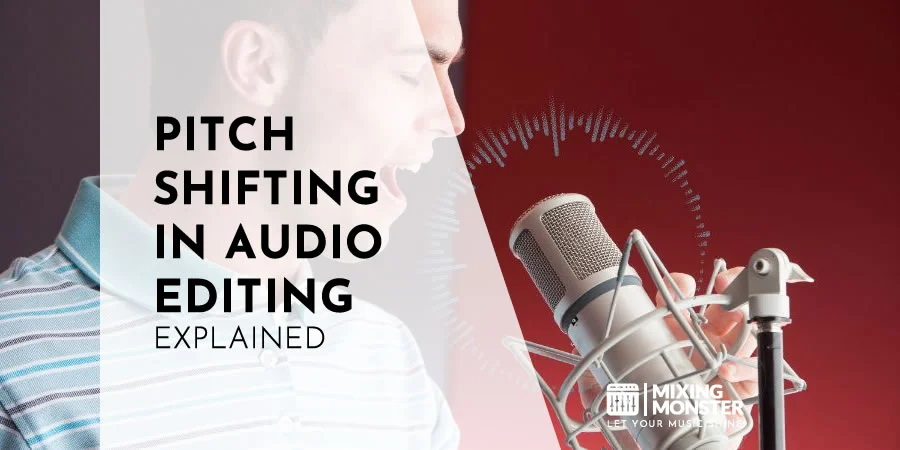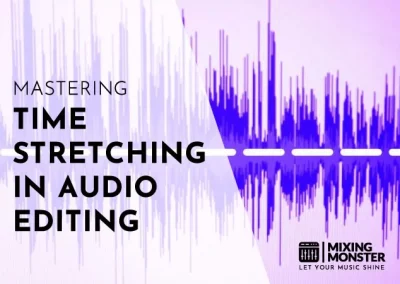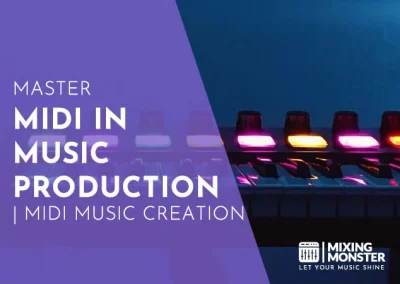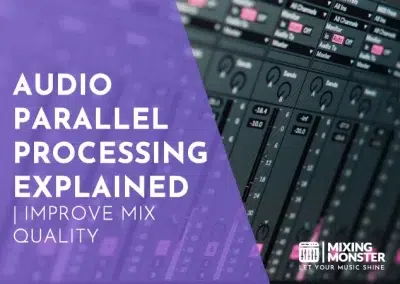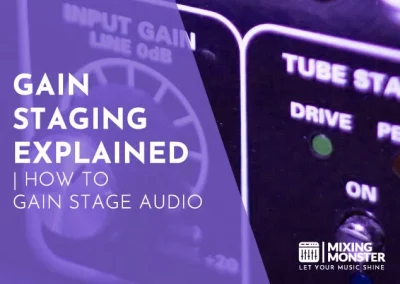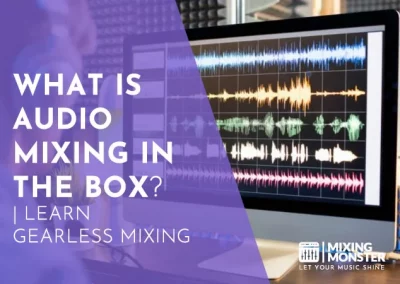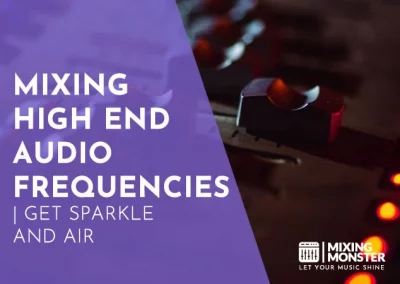Home > Blog > Editing > Editing Techniques
Disclosure: Some of the links below are affiliate links, meaning that at no additional cost to you, we will receive a commission if you click through and make a purchase. Read our full affiliate disclosure here.
Pitch shifting, the process of altering the original pitch of the audio, intrigues music producers and sound engineers alike. By manipulating the pitch, one can dramatically change the character and feel of a song, performance, or soundtrack without altering its tempo.
Pitch shifting is a technique used to modify the pitch of an audio signal while maintaining its duration and vice versa. This process is essential in various music production scenarios, including key changes, harmonization, and pitch correction. Technologies that analyze and transform the pitch of individual tones within a piece facilitate pitch shifting, either for creative purposes or to correct discrepancies.
Venturing further into the topic, you’ll discover the intricacies of pitch shifting and the creative possibilities it unveils. Expect to learn about the practical applications of this technology in modern music production, including the tools and techniques that enable artists to reach new heights of sonic experimentation.
KEY TAKEAWAYS:
- Pitch shifting alters audio pitch without changing tempo.
- This technique is crucial for critical adjustments and pitch correction in music.
- Modern tools provide innovative applications for creative sound manipulation.
Table Of Contents
1. What Is Audio Pitch Shifting?
2. Technical Aspects Of Audio Pitch Shifting
3. Pitch Shifting Applications In Music Production
4. Pitch Shifting Technology And Tools
5. Practical Pitch Shifting Tips And Techniques
6. FAQ

1. What Is Audio Pitch Shifting?
Audio pitch shifting is a technique that allows you to adjust the pitch of an audio signal, altering how high or low it sounds without impacting the playback speed. This capability is essential for various music production and sound design applications.
Understanding Audio Pitch And Frequency
- Pitch is the perceived frequency of a sound, how high or low it sounds to the ear. Musical notes are tied to specific pitches measured in Hertz (Hz).
- Frequency refers to the number of cycles a sound wave completes in one second. A higher frequency corresponds to a higher pitch, and vice versa.
A pitch shifter changes the pitch of audio signals. Shifting can be measured in semitones or octaves. A semitone is the smallest standard interval used in Western music, and an octave is an interval eight semitones apart, where the note’s frequency is doubled.
Audio Pitch Shifting Versus Time Stretching
- Pitch Shifting:
Refers to changing the audio pitch without modifying its tempo. If you adjust a guitar note by three semitones using a pitch shifter, the note will sound higher but be played back simultaneously. - Time Stretching:
In contrast, time stretching involves changing the duration of an audio clip, slowing down, or speeding up the playback without altering the original pitch.
Pitch shifting is often used to match the key of a song or create harmonies, while time stretching can adjust the length of a sample to fit within a certain time frame or sync it with other elements without changing the tonal quality.
2. Technical Aspects Of Audio Pitch Shifting
Understanding audio pitch shifting involves knowing the difference between analog and digital methods and the various algorithms used to manipulate pitch while preserving other aspects of the sound. It revolves around the technical manipulation of frequency, measured in hertz (Hz), to alter the perceived pitch of an audio signal.
Analog Versus Digital Pitch Shifting
Analog pitch shifting traditionally utilizes methods like varying the speed of tape playback. When you increase the speed, the waveform’s frequency rises, and the pitch sounds higher. Since this method also alters the tempo, it’s typically less precise than digital alternatives.
On the other hand, digital pitch shifting involves digital signal processing (DSP) techniques to modify a sound’s pitch without changing its duration or tempo. This method analyzes and manipulates the digital waveform, providing higher precision and versatility.
Your sounds are processed through intricate algorithms, meaning the pitch can be altered significantly without losing clarity or introducing undesired artifacts.
Pitch Shifting Algorithms
Algorithms are at the heart of digital pitch shifting. They define how the audio will be processed to achieve the desired pitch alteration. Below are some commonly used pitch-shifting techniques:
Time-Domain Algorithms:
- PSOLA (Pitch-Synchronous Overlap and Add) works by segmenting the audio stream into short sections (grains) that are overlapped and added at different intervals to change the pitch while keeping the same speed.
Frequency-Domain Algorithms:
- Phase Vocoder:
This technique uses the Fourier transform to shift pitches by manipulating phases and amplitudes of the signal’s frequency components. - Constant-Q Transform:
This method focuses on polyphonic music pitch shifting and uses logarithmic frequency-bin scaling to achieve the desired pitch.
Each algorithm’s effectiveness can vary depending on the complexity of the audio content and the extent of pitch modification required. Your choice of algorithm will significantly impact the quality and naturalness of the pitch-shifted audio.

3. Pitch Shifting Applications In Music Production
Pitch shifting is a versatile tool in music production. It allows you to manipulate audio in various creative ways. By using pitch shifting, you can enhance the overall sonic quality of your mixes by adding depth and texture to your compositions.
Creating Harmonies With Pitch Shifting
Pitch shifting is invaluable when you’re looking to add depth to your vocal tracks. By raising or lowering the pitch of a vocal sample, you can create harmonies where none existed, adding richness and complexity to your mix. For example, a single vocal line can be pitch-shifted to craft a full chord progression or reinforce a melody.
Shaping Audio Timbre And Character With Pitch Shifting
Using pitch shifting, you can alter the timbre and character of instruments in your recordings. This can be particularly useful with bass or electric guitar tracks, where slight pitch adjustments can contribute to a fuller or more unique sound. The right software can ensure that the timbre changes while preserving the original tempo and rhythm of the recording.
Manipulating Audio Tempo And Rhythm
Pitch shifting can also affect an audio clip’s perceived tempo and rhythm. In your digital audio workstation (DAW), you can modify the pitch to match the tempo of your project without altering the original clip’s speed or vice versa. This creates a seamless integration of disparate elements in your mix.
| Application | Use-Case | Benefit |
|---|---|---|
| Harmonies | Adding richness to vocals | Enhances the mix’s depth |
| Timbre | Altering instrument sounds | Creates unique sonic signatures |
| Tempo and Rhythm | Aligning elements in a mix | Maintains flow and cohesion |

4. Pitch Shifting Technology And Tools
Pitch-shifting technology has become indispensable in music production and sound design. You can access various tools, from software plugins to standalone hardware units, designed to alter pitch with precision and creativity.
Popular Pitch Shift Plugins
Your Digital Audio Workstation (DAW) can host a variety of pitch shift plugins that provide vast creative control. Two renowned names are Auto-Tune and Melodyne.
Auto-Tune is famed for its pitch correction capabilities, often used to achieve the iconic vocal effect heard in contemporary music. On the other hand, Melodyne offers intricate pitch editing and is revered for its natural-sounding results and polyphonic capabilities.
Another notable plugin is Soundtoys’ Little AlterBoy, a tool celebrated for its straightforward interface and ability to manipulate vocal formant and pitch effortlessly. This VST (Virtual Studio Technology) plugin can transform vocals into a different character.
Hardware Pitch Shifters
Moving beyond software, hardware pitch shifters like the Digitech Whammy pedal provide tactile control over pitch manipulation. Renowned for its use by guitarists, it can raise or lower notes by whole octaves, create harmonies, and produce classic pitch-bend effects.
These hardware units can be invaluable When performing live or seeking to integrate pitch shifting into your effects chain without a computer. They often come built to withstand the rigors of the road, making them a robust choice for touring musicians.

5. Practical Pitch Shifting Tips And Techniques
In mastering the subtleties of pitch shifting, your focus should be on maintaining clarity and avoiding unwanted artifacts. By understanding and applying these techniques, you can rest assured that your sound design will preserve the integrity of the original audio.
Optimizing Pitch Shift For Clarity
Formant Shifting:
When altering pitch, be mindful of the formant frequencies—these are crucial to maintaining natural sound character, especially in vocal recordings. A dedicated formant shifter can preserve vocal qualities even when the pitch is modified.
Harmonics:
A sound’s harmonics may be affected during pitch shifting, leading to a less clear or natural sound. Pay close attention to the harmonics; use high-quality algorithms or tools capable of subtle harmonic preservation.
Avoiding Common Pitch Shifting Artifacts
Tracking And Latency:
Fast and accurate tracking is key to avoiding artifacts such as glitches or ‘chipmunk’ effects. Choose pitch shifters with efficient tracking capabilities to minimize latency, which is especially important in real-time processing contexts.
Artifacts Mitigation:
Employ mild settings at first and incrementally adjust the pitch. Sudden large shifts are more likely to introduce distortion or artifacts. Use a preview function to fine-tune adjustments in your sound design projects before applying them.
Key Takeaways For Proper Pitch Shifting
- Understand The Tools:
Familiarize yourself with pitch-shifting software. One example is Melodyne, which offers cutting-edge capabilities within Pro Tools for real-time pitch manipulation. - Applications:
Recognize when to use pitch shifting. Use it to adjust an off-note in a vocal track or create harmonies and unique sound effects. - Maintain Quality:
Shift pitches carefully to avoid audio artifacts. Generally, gradual changes preserve quality better than extreme shifts. - Formant Shifting:
Consider the role of formants in pitch shifting. Adjusting formants can maintain a natural sound when changing pitch, especially in vocal processing. - Creative Exploration:
Experiment with pitch shifting for artistic effects. For example, you can lower a sound for a darker mood or raise it for an energetic feel. Resources like Get That Pro Sound offer insights into the creative potential of pitch manipulation. - Technique Refinement:
Cultivate your skills through practice and exploration. After all, pitch shifting is both a science and an art.
Happy pitch shifting!


6. FAQ
1) What software is commonly used for pitch shifting audio?
Software like Audacity, Melodyne, and Antares Auto-Tune are popular for pitch shifting audio. They offer precision control over pitch adjustments and are widely used in music production.
2) How does a pitch shifting pedal alter the sound of a guitar?
A pitch-shifting pedal manipulates the pitch of your guitar’s signal, creating harmonies or changing the key without altering your playing style. It manipulates the pitch by specific musical intervals.
3) Can you pitch shift vocals in real time with online tools?
Online tools like iZotope Nectar can be used for real-time pitch correction and vocal shifting. These tools provide live performance capabilities and studio editing flexibility.
4) What are the basic principles behind pitch shifting algorithms?
Pitch shifting algorithms function by altering the time-domain representation of audio signals. They modify the pitch without changing playback speed, preserving waveforms while shifting them upward or downward.
5) What are the differences between analog and digital pitch shifting?
Analog pitch shifting relies on hardware circuitry and can introduce coloration to your tone. On the other hand, digital pitch shifting uses algorithms to process the audio signal, offering more precision and flexibility.
6) How do you integrate a pitch shift plugin into a digital audio workstation?
To integrate a pitch shift plugin, you insert it onto an audio track within your digital audio workstation (DAW). Once loaded, you can access its interface to adjust the pitch settings for your project as desired.

